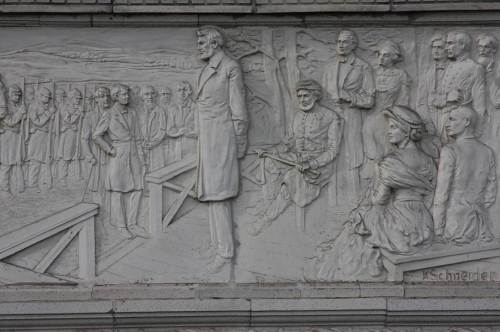Abraham Lincoln’s “few appropriate remarks” at Gettysburg, delivered 150 years ago today, are memorialized on Lincoln Hall on the University of Illinois campus. One of the biographical panels on the Quad side of the building depicts the president as he spoke. Pictured as seating directly behind him, according to the manufacturer of the panel in 1912, was an old man named Burke. So I once wrote, without confirming the name (Lincoln Hall at the University of Illinois. Urbana: University of Illinois Press, 2010). Not so, I soon learned from Wayne C. Temple (Ph.D., Illinois, 1956). His name was Burns.

John Burns, a veteran of the War of 1812, was nearly three score and ten years old when the Civil War came to Gettysburg on July 1, 1863. Although deemed too old for combat, he grabbed an old flintlock musket and trotted onto field of battle. His antique swallow-tail coat and stove pipe hat made him an easy target. Wounded and captured, he survived the battle.
Photographed by Matthew Brady, Burns was featured in Harper’s Weekly, and his story appeared in hundreds of papers across the North. When Lincoln came to Gettysburg, he asked about the old soldier and soon met him. If Burns did not sit on the platform when Lincoln spoke, as shown in the Lincoln Hall panel, he at least accompanied the president to the church service at the end of the day. Later, Lincoln signed an act of Congress giving Burns a pension “for patriotic services at Gettysburg.”
In 1864, Bret Harte, the California poet, celebrated Burns. “When the rebels rode through his native town,” he was “the only man who didn’t back down.” By contrast, “all his townsfolk ran away.” By 1911, even as “Burke” was being pictured in the terra cotta plaque on Lincoln Hall, Pennsylvania erected a bronze monument at Gettysburg for Burns, depicting him rather like Daniel Chester French’s “Minuteman” at the rude bridge in Concord.
But Burns claimed too much. He not only freely and inconsistently embellished his story, but he also belittled the deeds of others (calling one neighbor “a damned coward, a chicken hearted squaw, a tallow faced sissy”). For years, Burns, a cobbler by trade, had been regarded by Gettysburgians as eccentric and cantankerous, and today he is often known, erroneously, only as “the town drunk.”
The evidence about Burns, particularly at the battle, is too incomplete and contradictory to separate fact from fiction, as Timothy H. Smith’s John Burns, “The Hero of Gettysburg” (2000) makes clear. Moreover, as Carl Caldwell, another U. of I. alumnus has pointed out, Margaret S. Creighton has now brought to the foreground others than Burns, in The Colors of Courage: Gettysburg’s Forgotten History: Immigrants, Women, and African Americans in the Civil War’s Defining Battle (2005). But it is the story of John Burns, Gettysburg’s civilian warrior, that became particularly attached to the story of one of the nation’s most memorable texts. Much of the voluminous literature on that text, as well as graphic depictions of it, are part of the Library’s Illinois History and Lincoln Collections. — John Hoffmann, Illinois History & Lincoln Collections Librarian
